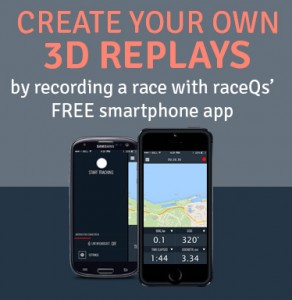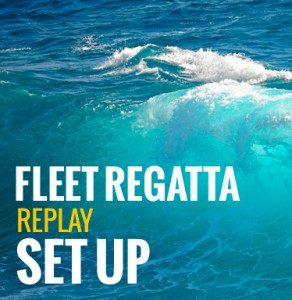This installment of the sailboat race starting series teaches you how to execute and avoid the pitfalls of the common dinghy race start. Also, get a quick tip on how to figure out which end of the starting line is favored.
The dinghy start only works for boats that have quick acceleration. It's easy to execute, as it does not require the advanced sense of time and distance needed for most large boat starting techniques. In fact, often times you can just park on the line next to an experienced competitor, and sheet in exactly when he does for a decent start. It's also important to evaluate which end of the starting line is favored, and decide if it's worth it to battle it out for favored position. Sometimes, the favored end of the line is not my favorite place to start. Watch this seven minute podcast to learn more.
Welcome to “Race to Win”, a sailing podcast brought to you by raceQs.com where we analyze raceQs’ 3d Regatta replays and review racing tactics, rules, and winning strategies.
Today’s podcast is the third one in a five part series about sailboat race starting strategies. Today we’re going to over the “dinghy start”, a classic small boat starting strategy that works well for almost any boat with quick acceleration.
You basically find your spot on the line and defend if without really moving around too much, and then bring your sails in and accelerate quickly to squirt over the line when the gun goes off.
This is an easy start to execute, buts its also pretty easy to screw up. If you sheet in too early, you’ll be over early. And if you sheet in too late, you’ll be late to the start.
The thing is, in these dinghy starts, everyone is often doing pretty much the same thing, so you’re going to get a big line of people all lined up on the starting line. This can actually be helpful if you are a beginner, because you can just look at the guy next to you- and when he sheets in, you sheet in. Off ya go.
Let’s get into the details. Just like before I am using this replay of the 2013 Melges world championships. In case you missed the earlier explanations, this green line is the pacer line, giving me my proper pace to approach the starting line on time. If your boat is moving along, right on the pacer line, you’re going to have an on time start. It you’re in front of it you’re early, and if you are behind it, you are late. We also have the fleet rankings and time to start here on the right hand side.
Something we haven’t talked about yet, so I will mention it briefly, is finding the favored end of the line. I like to think of the favored end as the part of the line that is “closest”, or furthest upwind to the windward mark. If you aren’t’ sure which end is favored, it’s really easy. Just sail up to the line and turn dead into the wind so that your sails are luffing right down the middle of the boat. When you are head to wind, whichever end of the line your bow is pointed closer too, is the favored end.
Easy, right?
So most of the time you would think, it would be better to start at the favored end of the line.
Once you figure that out, the big question is, is it worth it to try and start at the favored end? Do you really want to be battling it out for position, right in the middle of the pack? Or, is it better to start on the other side, where no body is around? Maybe you don’t have as good of position, but you can get clear air and get away from everyone battling it out.
Once you decide where on the line you want to start, you need a strategy to approach the line.
Just find your hole on the line, and sit there. When the guy next you pulls his sails in, you pull your sails, and off you go. In a crowded fleet, there is a problem with running out of room. If you don’t secure your position early enough, you are going ot end up in the second row. And once you are behind in these competitive one design fleets, it can be very difficult to get ahead.
Most of the time, in these dingy fleets. Where you start ,is where you finish. So if you start last you are probably going to be finishing pretty close to the end. Let’s watch an example of a Melges 24 executing kind of a modified version of the dingy start.
So keep an eye on boat 37, you can see from that colored line which is speed coded GPS track, he’s kind of been hanging out in this area. Now he’s stopped, he knows where he wants to go. Did you see that little acceleration there? He was not going to let that boat get his spot. And now, he’s early, he’s too early to the start so he’s going to come right up to the edge of the starting line, stop, lay in wait for this boat behind him, and just when he thinks he might sneak by, he accelerates up to the full speed, starts just right on time. So that is a good example of a dinghy start, but it happened pretty fast so let’s take a look at it again.
This time we are going to watch it from head on. The boats are actually sailing away from us right now. They are playing around in the starting area, trying to pick out his hole. Remember, the place on the line where he’s going to start. SO now, we are one minute from the start and her he his, stopped, just completely stopped. So WOOSH there’s that little spurt of sped again. That was a little to fast, he’s a little to early so hes gonna slow down and let the sails out a bit, and now here again, he’s going to come a to a total dead stop. The classic dinghy start. Here s comes that guy up behind him again, he’s not going to get in front of him though! Hes got his timing down, accelerates hard, whoosh, right over the line. Looks like he was late by six seconds. That’s pretty good, considering that amount of boats there are in this fleet.
You can see with the fleet rankings on the righ its really interesting to see who used wihich methods and how their start was. That’s all I have for you today. I hope that watching this series is helping you get down the basics of your starting techniques, or brush up if its been awhile. We look forward to talking about more advanced topics soon!
If you enjoyed this podcast, you can find more on our website. Www.raceqs.com/podcast. Or, search or raceqs.com on iTunes and click subscribe. We would love to hear from you so please give us a review on iTunes.











